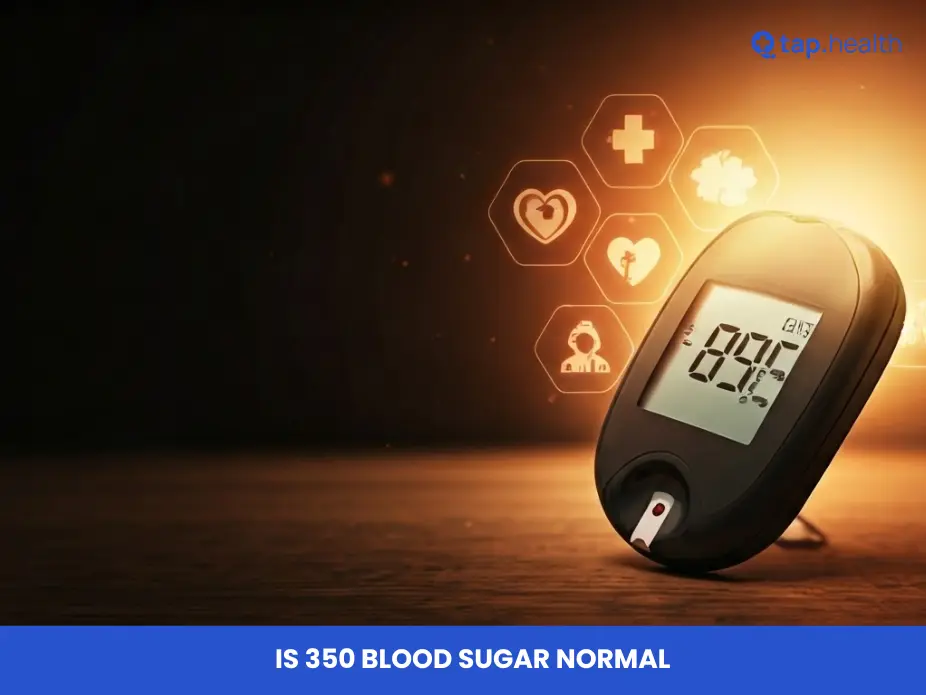Managing blood sugar levels is essential for maintaining good health, especially for individuals living with diabetes. A blood sugar level of 350 mg/dL is significantly higher than the normal range and can be alarming. But is 350 blood sugar normal? In this comprehensive blog post, we’ll explore what blood sugar levels mean, whether a level of 350 is considered normal, the dangers associated with high blood sugar, and effective strategies to manage and reduce elevated blood sugar levels.
Introduction
Blood sugar, or blood glucose, is the main sugar found in your blood and serves as the primary source of energy for your body’s cells. Keeping your blood sugar levels within a normal range is crucial for overall health and well-being. However, when blood sugar levels rise too high, it can lead to serious health complications. Understanding what constitutes normal and abnormal blood sugar levels can help you take proactive steps to manage your health effectively.
Understanding Blood Sugar Levels
What is Considered Normal Blood Sugar?
Normal blood sugar levels can vary depending on the time of day and when you last ate. Generally, for someone without diabetes:
- Fasting blood sugar (no food for at least 8 hours): 70-99 mg/dL
- Post-meal blood sugar (2 hours after eating): Less than 140 mg/dL
For individuals with diabetes, target ranges may be slightly higher, but consistently high levels can indicate poor blood sugar control. It’s essential to work with a healthcare provider to determine the appropriate targets for your specific situation.
How Blood Sugar Levels Affect Your Health
Maintaining blood sugar within the recommended range is vital for several reasons:
- Energy Levels: Proper blood sugar levels ensure your body has the energy it needs to function effectively throughout the day.
- Preventing Complications: Chronic high blood sugar can lead to severe health issues like heart disease, kidney damage, nerve problems, and vision loss.
- Overall Well-being: Balanced blood sugar contributes to better mood, concentration, and overall quality of life.
Is 350 Blood Sugar Normal?
A blood sugar level of 350 mg/dL is not considered normal. This level is significantly higher than the recommended range and indicates hyperglycemia, which can be dangerous if not addressed promptly. Such elevated levels suggest that your body is struggling to regulate glucose effectively, which can lead to immediate and long-term health complications.
Is 350 Blood Sugar Level Dangerous?
Yes, a blood sugar level of 350 mg/dL is dangerous. It signals that your body is unable to manage glucose effectively, which can result in severe health complications if left untreated. High blood sugar levels require immediate attention to prevent both short-term and long-term health issues.
The Significance of a 350 Blood Sugar Reading
Immediate Risks of Blood Sugar Levels Around 350
When blood sugar levels reach 350 mg/dL, immediate risks include:
- Diabetic Ketoacidosis (DKA): This is a serious condition where the body starts breaking down fats at an excessive rate, leading to a buildup of acids called ketones in the blood. DKA can be life-threatening if not treated promptly.
- Dehydration: High blood sugar causes increased urination, leading to significant loss of fluids and electrolytes.
- Severe Fatigue: The body cannot effectively use glucose for energy, resulting in extreme tiredness and weakness.
Long-Term Health Implications
Consistently high blood sugar levels can lead to long-term complications such as:
- Cardiovascular Disease: Increased risk of heart attacks, strokes, and hypertension due to damage to blood vessels.
- Kidney Damage: High glucose levels can damage the kidneys’ filtering system, potentially leading to kidney failure.
- Nerve Damage (Neuropathy): Excess sugar can injure nerves throughout the body, causing pain, tingling, or numbness, particularly in the extremities.
- Eye Problems (Retinopathy): Elevated blood sugar can lead to retinopathy, increasing the risk of blindness.
- Foot Problems: Poor circulation and nerve damage can lead to serious foot infections and, in severe cases, amputations.
- Skin Conditions: High blood sugar can make the skin more susceptible to bacterial and fungal infections.
- Dental Issues: Increased risk of gum disease and other oral health problems due to poor blood sugar control.
- Mental Health Issues: Chronic high blood sugar can contribute to depression, anxiety, and other mental health challenges.
Symptoms to Watch For at High Blood Sugar Levels
Recognizing Hyperglycemia Symptoms
Common symptoms of high blood sugar (hyperglycemia) include:
- Frequent Urination: Your kidneys work harder to filter and absorb the excess glucose, leading to increased urination.
- Increased Thirst: Dehydration from frequent urination leads to intense thirst.
- Blurred Vision: High blood sugar can cause the lenses of your eyes to swell, affecting vision.
- Headaches: Dehydration and electrolyte imbalances can result in headaches.
- Fatigue: The body’s inability to use glucose effectively leads to feelings of exhaustion.
- Slow-Healing Sores: High blood sugar can impair the body’s natural healing processes.
When to Seek Medical Attention
Seek immediate medical attention if you experience:
- Confusion or Difficulty Concentrating: Severe hyperglycemia can affect brain function.
- Shortness of Breath: This could be a sign of diabetic ketoacidosis or other serious conditions.
- Abdominal Pain: Persistent pain may indicate internal complications.
- Nausea and Vomiting: These symptoms can be signs of diabetic ketoacidosis.
- Unconsciousness: This is a medical emergency requiring immediate intervention.
These symptoms could indicate a severe condition like diabetic ketoacidosis, which requires urgent treatment to prevent life-threatening complications.
Managing and Reducing High Blood Sugar
Lifestyle Changes for Better Blood Sugar Control
Implementing the following lifestyle changes can help manage and reduce high blood sugar levels:
- Healthy Diet: Focus on low-carb, high-fiber foods like vegetables, whole grains, and lean proteins. Avoid sugary foods and refined carbohydrates that can spike blood sugar levels.
- Regular Exercise: Physical activity helps your body use insulin more effectively and can lower blood sugar levels. Aim for at least 150 minutes of moderate exercise per week.
- Weight Management: Maintaining a healthy weight reduces insulin resistance and helps regulate blood sugar levels.
- Stress Reduction: Chronic stress can elevate blood sugar levels. Practices like meditation, yoga, and deep-breathing exercises can help manage stress.
- Adequate Sleep: Poor sleep can affect blood sugar levels and insulin sensitivity. Aim for 7-9 hours of quality sleep each night.
- Hydration: Drinking plenty of water helps your kidneys flush out excess glucose through urine.
- Avoid Smoking and Limit Alcohol: Both smoking and excessive alcohol intake can negatively impact blood sugar control and overall health.
Medical Interventions for Critical Levels
When blood sugar levels are critically high, medical interventions may include:
- Insulin Therapy: Administering insulin can help lower blood sugar levels rapidly. Different types of insulin may be used depending on the situation.
- Medications: Certain medications can improve insulin sensitivity or reduce glucose production in the liver.
- Hospitalization: In severe cases, hospitalization may be necessary to stabilize blood sugar levels and treat complications like diabetic ketoacidosis.
- Monitoring: Continuous monitoring of blood sugar levels helps in adjusting treatments and preventing further complications.
How Bad is 350 Blood Sugar Level?
A blood sugar level of 350 mg/dL is considered very bad and poses significant health risks. It requires immediate attention to prevent acute complications such as diabetic ketoacidosis and long-term health issues like cardiovascular disease and nerve damage. Consistently high blood sugar levels can severely impact your quality of life and overall health, making it crucial to manage and lower these levels effectively.
Are There Any Lifestyle Changes That Can Help Manage a Blood Sugar Level of 350?
Yes, several lifestyle changes can help manage and reduce a blood sugar level of 350 mg/dL:
- Adopt a Balanced Diet: Incorporate more vegetables, whole grains, and lean proteins while reducing sugar and refined carbohydrates. Consider consulting a nutritionist for a personalized meal plan.
- Increase Physical Activity: Regular exercise helps improve insulin sensitivity and lowers blood sugar levels. Even light activities like walking can make a difference.
- Monitor Blood Sugar Levels: Regular monitoring helps track progress and adjust treatments as needed. Use a reliable glucose meter and keep a log of your readings.
- Stay Hydrated: Drinking plenty of water helps your kidneys flush out excess glucose. Aim for at least 8 glasses of water a day.
- Avoid Smoking and Limit Alcohol: Both smoking and excessive alcohol intake can negatively impact blood sugar control and overall health.
- Manage Stress: Stress can increase blood sugar levels. Practice stress-reducing techniques like meditation, yoga, or deep-breathing exercises.
- Get Adequate Sleep: Aim for 7-9 hours of quality sleep each night to help regulate hormones that affect blood sugar.
What Are the Long-Term Effects of Consistently Having a Blood Sugar Level of 350?
Consistently high blood sugar levels can lead to severe long-term health complications, including:
- Cardiovascular Disease: High blood sugar can damage blood vessels, increasing the risk of heart attacks, strokes, and hypertension.
- Kidney Failure: Prolonged hyperglycemia can damage the kidneys’ filtering system, leading to chronic kidney disease or kidney failure.
- Nerve Damage (Neuropathy): Excess sugar can injure nerves throughout the body, causing pain, tingling, numbness, or weakness, especially in the hands and feet.
- Vision Loss (Retinopathy): High blood sugar can damage the blood vessels in the retina, leading to vision problems and even blindness.
- Foot Problems: Poor circulation and nerve damage can lead to serious foot infections, ulcers, and in severe cases, amputations.
- Skin Conditions: High blood sugar can make the skin more susceptible to bacterial and fungal infections.
- Dental Issues: Increased risk of gum disease and other oral health problems due to poor blood sugar control.
- Mental Health Issues: Chronic high blood sugar can contribute to depression, anxiety, and other mental health challenges.
These complications not only affect physical health but can also significantly impact emotional and mental well-being, highlighting the importance of maintaining healthy blood sugar levels.
How Do You Lower a Blood Sugar of 350?
Lowering a blood sugar level of 350 mg/dL involves a combination of immediate actions and long-term strategies:
- Take Prescribed Medications: Follow your healthcare provider’s instructions regarding insulin or other medications. Do not adjust your dosage without consulting your doctor.
- Hydrate: Drink plenty of water to help flush out excess glucose through urine. Staying hydrated is essential for managing high blood sugar.
- Exercise: Engage in light physical activity, such as walking or stretching. Physical activity helps your body use insulin more effectively, but avoid strenuous exercise if you are very high.
- Monitor Blood Sugar: Keep track of your blood sugar levels to ensure they are coming down. Regular monitoring helps in adjusting treatments as needed.
- Follow a Healthy Diet: Avoid sugary foods and refined carbohydrates. Focus on low-carb, high-fiber foods that can help stabilize blood sugar levels.
- Seek Medical Advice: If your blood sugar remains high despite these measures, contact your healthcare provider for further guidance.
How Do You Treat Blood Sugar of 350?
Treating a blood sugar level of 350 mg/dL typically involves:
- Insulin Administration: Rapid-acting insulin may be necessary to bring levels down quickly. Your healthcare provider will determine the appropriate dosage based on your specific needs.
- Hydration Therapy: Intravenous fluids may be required in severe cases to address dehydration and help lower blood sugar levels.
- Electrolyte Replacement: Balancing electrolytes if there is significant loss through urine is crucial for preventing complications.
- Medical Supervision: Continuous monitoring in a healthcare setting ensures safe and effective reduction of blood sugar levels and management of any complications.
- Addressing Underlying Causes: Identifying and treating any underlying issues, such as infection or illness, that may be contributing to high blood sugar levels.
Immediate medical intervention is essential to prevent life-threatening complications and stabilize your condition.
What Do You Eat if Blood Sugar is 350?
When blood sugar is high, focus on foods that can help lower it:
- Non-Starchy Vegetables: Such as spinach, broccoli, peppers, and kale. These vegetables are low in carbohydrates and high in fiber.
- Lean Proteins: Like chicken, turkey, fish, and tofu. Protein helps stabilize blood sugar levels without causing spikes.
- Whole Grains: Opt for brown rice, quinoa, and oats in moderation. Whole grains provide fiber and nutrients without rapidly increasing blood sugar.
- Healthy Fats: Include avocados, nuts, seeds, and olive oil. Healthy fats can help slow the absorption of glucose.
- Low-Glycemic Fruits: Such as berries and green apples in moderation. These fruits have a lower impact on blood sugar compared to others.
- Legumes: Beans, lentils, and chickpeas are high in fiber and protein, making them excellent for blood sugar control.
Foods to Avoid:
- Sugary Foods and Beverages: Such as candy, soda, and desserts, which can cause rapid spikes in blood sugar levels.
- Refined Carbohydrates: Like white bread, pasta, and pastries, which lack fiber and can quickly elevate blood sugar.
- High-Fat Foods: Especially those high in saturated and trans fats, which can worsen insulin resistance and contribute to heart disease.
- Processed Foods: Often high in sugar, unhealthy fats, and sodium, which can negatively impact blood sugar control.
Focusing on a balanced diet rich in whole foods can help manage and reduce high blood sugar levels effectively.
When Should Medical Attention Be Sought for a Blood Sugar Level of 350?
Seek medical attention immediately if you have a blood sugar level of 350 mg/dL, especially if you experience symptoms like:
- Confusion or Disorientation: High blood sugar can affect brain function, leading to confusion or difficulty concentrating.
- Shortness of Breath: Difficulty breathing can be a sign of diabetic ketoacidosis or other severe conditions.
- Severe Thirst or Dehydration: Excessive loss of fluids can lead to dehydration, requiring medical intervention.
- Nausea and Vomiting: Persistent vomiting can indicate diabetic ketoacidosis, a life-threatening condition.
- Chest Pain or Irregular Heartbeat: These symptoms could indicate a heart attack or other cardiovascular issues.
Immediate medical attention is crucial to prevent complications and stabilize blood sugar levels effectively.
Is 350 Blood Sugar Normal? Decoding your health
FAQ on Is 350 Blood Sugar Normal
1.Is Blood Sugar of 350 Dangerous?
Yes, a blood sugar level of 350 mg/dL is dangerous and requires immediate medical attention to prevent serious health complications.
2.What Happens if the Sugar Level is 350?
A blood sugar level of 350 mg/dL can lead to symptoms like extreme thirst, frequent urination, fatigue, and in severe cases, diabetic ketoacidosis, which is life-threatening.
3.How Do You Treat Blood Sugar of 350?
Treatment typically involves administering insulin, staying hydrated, monitoring blood sugar levels closely, and seeking medical supervision to manage and lower the levels safely.
What Happens if Your Blood Sugar is 300?
A blood sugar level of 300 mg/dL is also considered high and can lead to similar symptoms and risks as a level of 350 mg/dL, including the potential for diabetic ketoacidosis.
4.What Should I Eat if My Blood Sugar is 300?
Focus on low-carb, high-fiber foods such as non-starchy vegetables, lean proteins, and whole grains. Avoid sugary and refined foods that can further elevate blood sugar levels.
5.What Are Healthy Blood Sugar Levels?
For most adults without diabetes:
- Fasting: 70-99 mg/dL
- Post-Meal: Less than 140 mg/dL
Individuals with diabetes may have slightly higher target ranges as advised by their healthcare provider.
6.Is Blood Glucose of 170 Hyperglycemia?
Yes, a blood glucose level of 170 mg/dL is considered hyperglycemia, especially if it occurs consistently or without recent food intake.
7.At What Point Should Medical Attention Be Sought for a Blood Sugar Level of 350?
Immediate medical attention should be sought when blood sugar levels reach 350 mg/dL, particularly if accompanied by severe symptoms like confusion, shortness of breath, or vomiting.
8.Are There Any Lifestyle Changes That Can Help Manage a Blood Sugar Level of 350?
Yes, adopting a balanced diet, increasing physical activity, maintaining a healthy weight, reducing stress, and quitting smoking can help manage high blood sugar levels.
9.What Are the Long-Term Effects of Consistently Having a Blood Sugar Level of 350?
Consistently high blood sugar can lead to cardiovascular disease, kidney failure, nerve damage, vision loss, and increased risk of infections.
10.How Do You Lower a Blood Sugar of 350?
Lowering blood sugar from 350 mg/dL involves taking prescribed medications or insulin, staying hydrated, exercising, and closely monitoring your levels.
11.My Sugar Level is 350 After Meal
If your blood sugar is 350 mg/dL after a meal, it’s important to follow your diabetes management plan, which may include taking insulin or other medications and consulting your healthcare provider.
12.My Blood Sugar is Over 300 What Should I Do?
If your blood sugar is over 300 mg/dL, take your prescribed insulin or medications, hydrate, avoid high-carb foods, and seek medical advice if levels do not decrease or if you experience severe symptoms.
13.Is Blood Sugar Level of 400 Dangerous?
Yes, a blood sugar level of 400 mg/dL is extremely dangerous and requires immediate medical attention to prevent life-threatening complications.
14.How to Reduce Blood Sugar Level Immediately
To reduce blood sugar levels immediately:
- Take Insulin as Prescribed
- Drink Water to Stay Hydrated
- Engage in Light Physical Activity
- Avoid Carbohydrates and Sugary Foods
Normal Blood Sugar Levels Chart
| Condition | Fasting (mg/dL) | Post-Meal (mg/dL) |
|---|---|---|
| Normal | 70-99 | <140 |
| Prediabetes | 100-125 | 140-199 |
| Diabetes | 126+ | 200+ |
15.What Level of Blood Sugar is Dangerous?
Blood sugar levels consistently above 180 mg/dL post-meal or above 130 mg/dL fasting can be dangerous, increasing the risk of long-term complications. Levels above 300 mg/dL are considered medical emergencies.
16.What Level of Blood Sugar is Dangerous for Type 2 Diabetes?
For individuals with type 2 diabetes, blood sugar levels above 240 mg/dL require medical attention, while levels above 300 mg/dL are considered dangerous.
17.What Foods Lower Blood Sugar Immediately
Foods that can help lower blood sugar immediately include:
- Non-Starchy Vegetables: Such as spinach and broccoli.
- Lean Proteins: Like chicken and fish.
- Healthy Fats: Avocados and nuts.
- Cinnamon: May help improve insulin sensitivity.
18.How Bad is 350 Blood Sugar Level
A blood sugar level of 350 mg/dL is very bad and poses significant risks of acute and chronic health complications, necessitating immediate action.
19.Is 350 Diabetes High
Yes, a blood sugar level of 350 mg/dL is considered very high for individuals with diabetes and requires urgent medical attention.
20.Blood Sugar Level 350 is Normal
No, a blood sugar level of 350 mg/dL is not normal. It indicates hyperglycemia and requires immediate management to prevent serious health issues.
21.What Happens if the Sugar Level is 350?
A sugar level of 350 mg/dL can lead to dehydration, diabetic ketoacidosis, severe fatigue, and other life-threatening conditions if not treated promptly.
22.How Do You Treat Blood Sugar of 350?
Treatment involves administering insulin or other medications, staying hydrated, monitoring blood sugar levels, and seeking medical supervision to manage and lower the levels safely.
23.What Happens if Your Blood Sugar is 300?
A blood sugar level of 300 mg/dL can cause similar symptoms to 350 mg/dL, including dehydration, dizziness, and in severe cases, diabetic ketoacidosis.
24.What Should I Eat if My Blood Sugar is 300?
When your blood sugar is 300 mg/dL, focus on eating:
- Non-Starchy Vegetables: Such as kale and zucchini.
- Lean Proteins: Like turkey and tofu.
- Whole Grains: Opt for quinoa or brown rice in moderation.
- Healthy Fats: Include nuts and olive oil.
Avoid sugary snacks, beverages, and refined carbohydrates.
Conclusion
A blood sugar level of 350 mg/dL is not normal and poses significant health risks. Understanding the causes, recognizing the symptoms, and taking immediate action to manage and reduce high blood sugar levels are crucial for maintaining your health. Adopting a healthy lifestyle, adhering to prescribed medications, and regularly monitoring your blood sugar can help keep it within a safe range. Always consult with healthcare professionals to tailor a management plan that suits your individual needs and prevents both acute and long-term complications.
References
- Mayo Clinic – Diabetes Management
- National Institute of Diabetes and Digestive and Kidney Diseases
- Centers for Disease Control and Prevention – High Blood Sugar
- Harvard Health – Understanding Blood Sugar Levels



